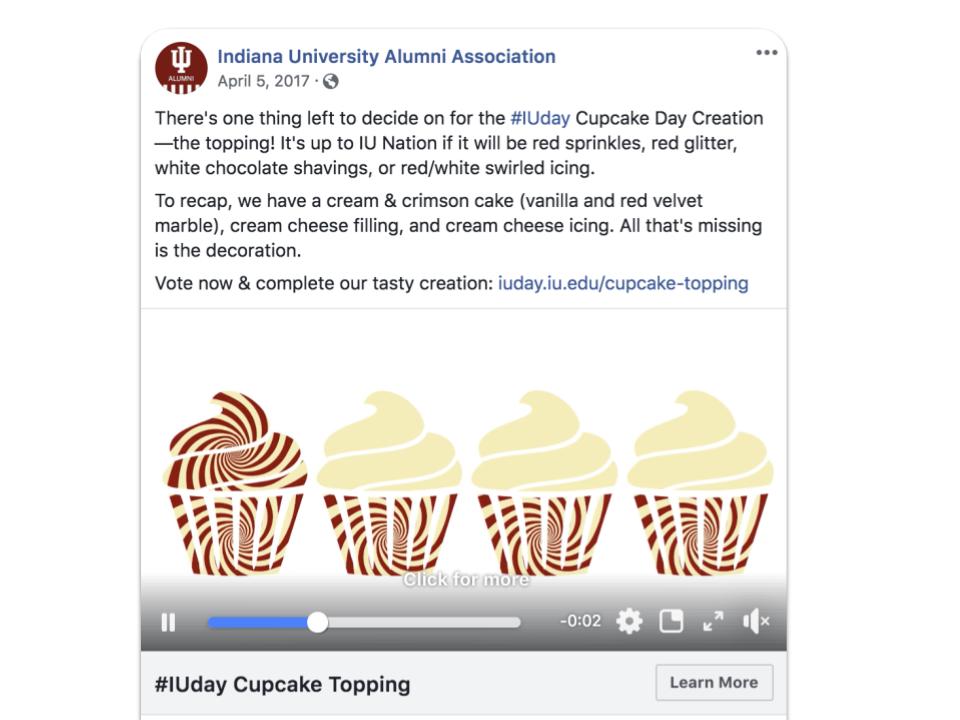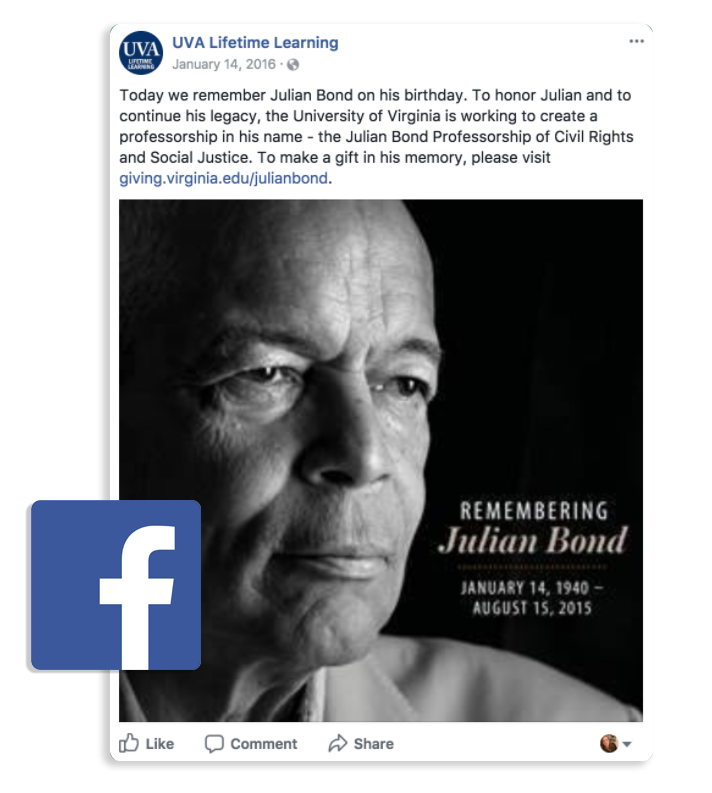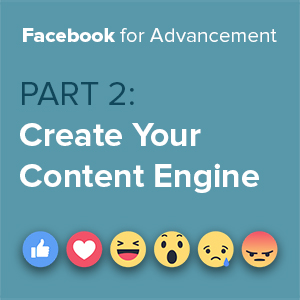It’s Part 2 of our Facebook for Advancement series. Today we’re getting into content. How to create it, where to get inspiration, and what to do what it’s out there.
We’ve established that Facebook is absolutely still relevant, even with its tenured status. Now you’re convinced (assuming we did everything right in our last post, anyway) that Facebook needs more of your attention…what do you actually DO next?
That’s a very fair question to be asking. It starts with rethinking your whole approach to posting on Facebook. Which is no small task. We get it. But in order to get more powerful results, you’ve got to create a content engine and streamline it specifically for Facebook.
Let’s get into how you can start doing just that.
FOUR THINGS YOUR CONTENT ENGINE NEEDS TO DO
First things first, start with some goals. That way, as you hone and refine your process, you know what you’re going for. In our humble opinion, your content engine should strive to accomplish each of the following:
- Tell great stories.
- Cater specifically to Facebook
- Align to fundraising goals
- (Hold tight. We’re putting this one aside for a minute.)
Tell Great Stories
This, obviously, is easier said than done. But can also be a whole lot of fun to do. To start with, think beyond beautiful pictures of your campus and press releases. Like anyone, we’re suckers for gorgeous shots of your quad (press releases…not so much), but other than stirring up some nostalgia, what are they really doing for alumni?
Take a step outside your office. Look around. See what’s happening on campus. See what’s happening with your alumni beyond campus. Great stuff is going to be staring you in the face. If you look beyond that beautiful campus of yours, that is. Identify that stuff, capture it in photos or on video, and get it on your social channels.
Cater Specifically to Facebook
You don’t want to post a magazine article or postcard on Facebook. It’s the wrong medium. You might be great at producing that stuff, but instead think about what you like to engage with while you’re scrolling through your newsfeed. Now take that approach to your own content. Think video. Think live streams. If it grabs your attention, you won’t be alone.
The best part is, it’s free to get it in front of your audience. You don’t need updated mailing addresses, emails, or phone numbers. If you’re constituents are on Facebook (and they almost definitely are), they’ll see it almost as soon as you’re finished creating it.
Align to Fundraising Goals
What are you raising money for? That’s the first question to ask before you start creating anything. Fundraising goals should be directly reflected on your social channels. That doesn’t mean you straight up ask for donations to help build a new library. Instead, share plans for your new library or a video of excited students talking about all the possibilities it will open for them. Then post that to Facebook for the world to see.
EXAMPLE BREAK
Here’s a quick look at some recent examples that are right on the money (and plenty successful).
Indiana University’s Cupcake Day
IU asked the audience on their Facebook alumni page what kind of cupcake should be created for students on IU Day. Simple enough, right?

They reached over 10 million people in 84 countries. Which is great. Then they turned that into 3,400 gifts in support of the university. Which is even better.
All from a cupcake topping.
Oklahoma State’s Orange Passion
The Oklahoma State team asked themselves what they were trying to money for. Then they asked what they could post about those projects without, and this is crucial, asking for donations.
So they appealed to people’s passions by creating content related to giving opportunities, which they call Orange Passions. An effort to raise money for the veterinary program yielded some exciting posts about news from the school. Behind the scenes looks at the football team were created as a result of an initiative for the team.

Based on some follow up (which we’ll get too soon), they generated $610,000 from over 1,300 donors who engaged with these pieces of content. All it took was a little forethought.
University of Virginia’s In Memoriam
The passing of a beloved faculty member is never easy for any campus. To honor the legacy of Julian Bond, the University of Virginia announced a scholarship in his honor on his birthday.

They were able to close out a $3 million scholarship thanks in no small part to gifts from people who interacted with these posts.
FOLLOW UP IS EVERYTHING
Alright, let’s circle back to point number 4 we mentioned earlier.
- Engage > Qualify > Assign > Solicit
The work doesn’t stop once you get your content live on Facebook. By looking through who is interacting with what you’ve posted, you can identify potential donors. People engage with the content that resonates with them. Once you identify what they’re interested in, your gift officers have a natural starting point for personal outreach. Instead of asking for a gift to your university at large, they can focus on gifts that will impact the donor’s passions. Passions they told you about themselves.
You can easily automate this segmentation with EverTrue, but you can certainly do it manually as well. By personalizing your ask and speaking directly to their interests, your chances of getting a gift increases exponentially.
And that is how your Facebook content unlocks the ability to make a better connection with any potential donor.
Why wait to get your content engine going? Start thinking (or creating) new content then check back for all the FREE tools Facebook lets you take advantage of in the third part of our Facebook for Advancement series, coming soon.

